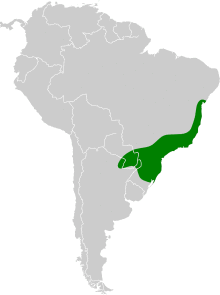| Fringed fruit-eating bat | |
|---|---|
 | |
| Scientific classification | |
| Kingdom: | Animalia |
| Phylum: | Chordata |
| Class: | Mammalia |
| Order: | Chiroptera |
| Family: | Phyllostomidae |
| Genus: | Artibeus |
| Species: | A. fimbriatus |
| Binomial name | |
| Artibeus fimbriatus Gray, 1838 | |
 | |
The fringed fruit-eating bat (Artibeus fimbriatus), is a species of bat native to South America.[2]
Distribution and habitat
It is found in Argentina, Brazil and Paraguay.[1]
Fringed fruit-eating bats inhabit regions with tropical climates and thrive in areas with little rainfall and sunny days. This species is dependent on abiotic factors in the wild.[3]
Behaviour and ecology
Breeding
Their reproduction process is dependent on both the time of day and climatic factors. The process begins in warmer seasons with longer hours of daylight.[4]
Feeding
For scavenging, they mainly feed on fruits and seeds, but predominately eat ficus and leafy bushes.[5]
Threats
While not currently threatened with extinction, changes to the forests and forest community may lead to a steadily decline in the bat population.[6]
References
- ^ a b Barquez, R.; Diaz, M. (2015). "Artibeus fimbriatus". IUCN Red List of Threatened Species. 2015: e.T2126A21999829. doi:10.2305/IUCN.UK.2015-4.RLTS.T2126A21999829.en.
- ^ Simmons, N.B. (2005). "Order Chiroptera". In Wilson, D.E.; Reeder, D.M (eds.). Mammal Species of the World: A Taxonomic and Geographic Reference (3rd ed.). Johns Hopkins University Press. p. 418. ISBN 978-0-8018-8221-0. OCLC 62265494.
- ^ Lima, C. S. & Fabián, M. E. (Fall 2019). "Reproductive biology of Artibeus fimbriatus Gray 1838 (Chiroptera) at the southern limit of its geographic range". Biota Neotropica. 16.
- ^ Filho, H. O.; Reis, N. & Minte-Vera, C. (Fall 2019). "Time and seasonal patterns of activity of phyllostomid in fragments of a stational semidecidual forest from the Upper Paraná River, Southern Brazil". Brazilian Journal of Biology. 70 (4): 937–945. doi:10.1590/S1519-69842010000500004. PMID 21180897.
- ^ Weber, M. D. M.; Arruda, J. L. S. D.; Azambuja, B. O.; Camilotti, V. L. & Cáceres, N. C. (Fall 2019). "Resources partitioning in a fruit bat community of the southern Atlantic Forest". Mammalia. 75: 217–225.
- ^ Gallo, PH; dos Reis, NR; Andrade, FR; de Almeida, IG; Patricia Helena; Nelio Roberto; Fabio Rodrigo; Inae Guion (Fall 2019). "Bats (Mammalia: Chiroptera) in native and reforested areas in Rancho Alegre, Parana, Brazil". University of Illinois Scientific Library Index. 58: 1311–1322 – via University of Illinois at Chicago Library Scientific Index.
